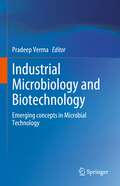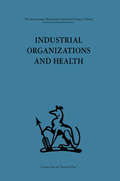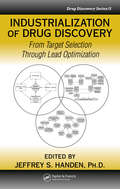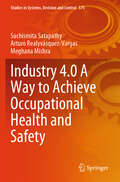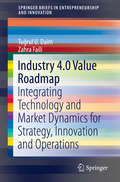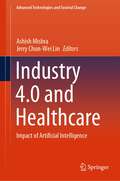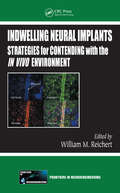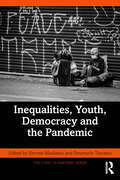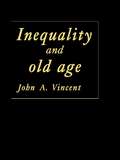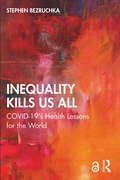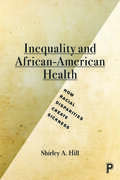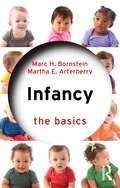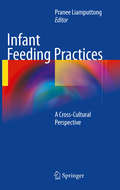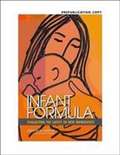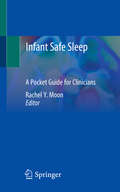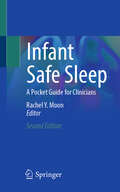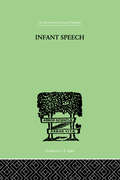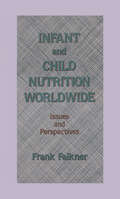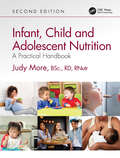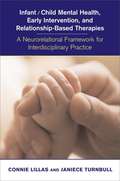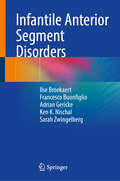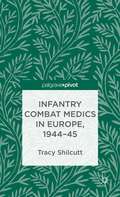- Table View
- List View
Industrial Microbiology and Biotechnology: Emerging concepts in Microbial Technology
by Pradeep VermaThe second volume of the Book-Industrial Microbiology and Biotechnology covers various emerging concepts in microbial technology which have been developed to harness the potential of the microbes. The book examines the microbes-based products that have widespread applications in various domains i.e., agriculture, biorefinery, bioremediation, pharmaceutical, and medical sectors. It focusses on recent advances and emerging topics such as CRISPR technology, advanced topics of genomics, including functional genomics, metagenomics, metabolomics, and structural and system biology approaches for enhanced production of industrially relevant products. It further gives an insight into the advancement of genetic engineering with special emphasis on value-added products via microalgal systems and their techno-economics analysis and life cycle assessment. The book towards the end presents recent advancements in the use of microbes for the production of industrial relevant enzymes, amino acids, vitamins, and nutraceuticals, on vaccine development and their biomedical applications. The book is an essential source for researchers working in allied fields of microbiology, biotechnology, and bioengineering.
Industrial Organizations and Health
by Frank Baker Alan Sheldon Peter J. M. McEwanTavistock Press was established as a co-operative venture between the Tavistock Institute and Routledge & Kegan Paul (RKP) in the 1950s to produce a series of major contributions across the social sciences. This volume is part of a 2001 reissue of a selection of those important works which have since gone out of print, or are difficult to locate. Published by Routledge, 112 volumes in total are being brought together under the name The International Behavioural and Social Sciences Library: Classics from the Tavistock Press. Reproduced here in facsimile, this volume was originally published in 1969 and is available individually. The collection is also available in a number of themed mini-sets of between 5 and 13 volumes, or as a complete collection.
Industrial Starch Debranching Enzymes
by Jing Wu Wei XiaThe book presents a systematic and detailed introduction on starch debranching enzymes concerning the classification, biochemical properties, features on sequences and structures, enzyme engineering, production, and current applications. All relevant contents are organized to focus on characteristics, productions and industrial applications of the starch debranching enzymes. It is purposed to deepen the understandings on the pre-existing researches, developments, and bottlenecks, and also to discuss the research hotspots and application perspectives of starch debranching enzymes. The book is written for researchers, professional/practitioners and graduate students in the field of enzymology, microbiology, and food science etc.
Industrialization of Drug Discovery: From Target Selection Through Lead Optimization (Drug Discovery Series)
by Jeffrey S. HandenThe drug discovery and development process is getting longer, more expensive, and no better. The industry suffers from the same clinical attrition and safety-related market withdrawal rates today as it did 20 years ago. Industrialization of Drug Discovery: From Target Selection Through Lead Optimization scrutinizes these problems in detail, contras
Industry 4.0 A Way to Achieve Occupational Health and Safety (Studies in Systems, Decision and Control #575)
by Arturo Realyvásquez-Vargas Suchismita Satapathy Meghana MishraThis book consists of advances in data intelligence and its applications in sustainable computing and explores challenges of Industry 4.0. Occupational health and safety is a problem faced by many industries. It effects health, safety, and also wellbeing of employees and workers engaged. Industry 4.0 has changed the total scenario of many industries. Safety and sustainability are two major problems with most industries and other emerging sectors. So, safety is a most important criterion and is often taken care of by framing and following safety policies. Soft computing methods are used to resolve all innovative and research problems in engineering, manufacturing, and business management areas. Much innovative design and sustainable solutions are resolved by IoT and AI techniques. Any troublesome work without hard labor and with easy approaches can be resolved by IoT, which is safer and can be learned quickly. It will help research and find a significant replacement with innovative solutions to any technical and business-related problems. A huge and developing number of producers acknowledge generous monetary and natural advantages from feasible strategic policies. Manageable assembling makes items through financially strong cycles that limit adverse ecological effects while moderating energy and regular assets. Sustainable manufacturing also enhances employee, community, and product safety. A developing number of organizations are treating sustainability as a significant goal in their procedure and activities to build development and worldwide intensity practices in every place of manufacturing industries. Automation systems usually make workplaces safer by keeping people out of dangerous situations. They also encourage inclusion by substituting less physically demanding computer-based monitoring activities with jobs requiring strength or agility. The shift from a physically oriented to a knowledge-based work environment substitutes more intellectual, decentralised decision-making stresses for workplace problems like repeated actions.
Industry 4.0 Value Roadmap: Integrating Technology and Market Dynamics for Strategy, Innovation and Operations (SpringerBriefs in Entrepreneurship and Innovation)
by Tuğrul U. Daim Zahra FailiIndustry 4.0 has altered as well as disrupted the business model of organizations around the world. The adoption however, has been slow in the various industries as a clear roadmap for the integration of the same lacks in project planning. This brief fills this gap as it examines the development of a Value Roadmap for different industries using Industry 4.0 as an enabler. Using the automotive, healthcare and telecommunication industries as case studies, the authors create the value roadmap using five factors: market drivers, product features, technology features, enablers and resources. This framework integrates both technology and market knowledge to support strategy development, innovation and operational processes in organizations.
Industry 4.0 and Healthcare: Impact of Artificial Intelligence (Advanced Technologies and Societal Change)
by Jerry Chun-Wei Lin Ashish MishraThis book presents different stages of Industrial Revolution in artificial intelligence and its impact on industry 4.0 and Healthcare. It contains chapters prepared for the industrial landscape which is being transformed to the fourth stage with the rise of autonomous robots, contemporary automation, cyber-physical systems, the Internet of things, and the Internet of services for examining the circumstances of health care system for the future. It highlights the emerging trends in integration of different intelligent manufacturing systems and advanced information technologies. Additionally, understanding of the real-world issues using artificial intelligence and the solutions discussed in this book help the enormous numbers of techniques which can be applied for effective diagnosis and predicting diseases from health care data.
Indwelling Neural Implants: Strategies for Contending with the In Vivo Environment
by William M. ReichertDespite enormous advances made in the development of external effector prosthetics over the last quarter century, significant questions remain, especially those concerning signal degradation that occurs with chronically implanted neuroelectrodes. Offering contributions from pioneering researchers in neuroprosthetics and tissue repair, Indwel
Inequalities, Youth, Democracy and the Pandemic (The COVID-19 Pandemic Series)
by Simone MaddanuThis book brings together studies from various locations to examine the growing social problems that have been brought to the fore by the COVID-19 outbreak. Employing both qualitative, theoretical and quantitative methods, it presents the impact of the pandemic in different settings, shedding light on political and cultural realities around the world. With attention to inequalities rooted in race and ethnicity, economic conditions, gender, disability, and age, it considers different forms of marginalization and examines the ongoing disjunctions that increasingly characterize contemporary democracies from a multilevel perspective.The book addresses original analyses and approaches from a global perspective on the COVID-19 pandemic, its governance, and its effects in different geographies. These analyses are organized around three main axes: 1) how COVID-19 pandemic worsened social, racial/ethnic, and economic inequalities, including variables such as migration status, gender, and disability; 2) how the pandemic impacted youth and how younger generations cope with public health alarms, and containment measures; 3) how the pandemic posed a challenge to democracy, reshaped the political agenda, and the debate in the public sphere. Contributions from around the world show how local and national issues may overlap on a global scale, laying the foundation for connected sociologies. Based on qualitative as well as quantitative empirical analysis on various categories of individuals and groups, this edited volume reflects on the sociological aspects of current planetary crises which will continue to be at the core of our societies.A wide-ranging, international volume that focuses on both unexpected social changes and new forms of agency in response to a period of crisis, Inequalities, Youth, Democracy and the Pandemic will appeal to scholars with interests in the sociology of health, social problems and inequalities.
Inequality And Old Age
by John A VincentAn analysis of ageing in relation to identity formation, inequality and stratification. The book outlines a theory of social inequality which encompasses those inequalities associated with old age - in addition to class, gender, race and ethnicity.; This book is intended for undergraduate and postgraduate sociology courses in social stratification and social theory, as well as students and researchers in social policy, social welfare and health with an interest in the study of ageing.
Inequality Kills Us All: COVID-19's Health Lessons for the World
by Stephen BezruchkaThe complex answer to why the United States does so poorly in health measures has at its base one pervasive issue: The United States has by far the highest levels of inequality of all the rich countries. Inequality Kills Us All details how living in a society with entrenched hierarchies increases the negative effects of illnesses for everyone. The antidote must start, Stephen Bezruchka recognizes, with a broader awareness of the nature of the problem, and out of that understanding policies that eliminate these inequalities: A fair system of taxation, so that the rich are paying their share; support for child well-being, including paid parental leave, continued monthly child support payments, and equitable educational opportunities; universal access to healthcare; and a guaranteed income for all Americans. The aim is to have a society that treats everyone well—and health will follow.
Inequality Kills Us All: COVID-19's Health Lessons for the World
by Stephen BezruchkaThe complex answer to why the United States does so poorly in health measures has at its base one pervasive issue: The United States has by far the highest levels of inequality of all the rich countries. Inequality Kills Us All details how living in a society with entrenched hierarchies increases the negative effects of illnesses for everyone. The antidote must start, Stephen Bezruchka recognizes, with a broader awareness of the nature of the problem, and out of that understanding policies that eliminate these inequalities: A fair system of taxation, so that the rich are paying their share; support for child well-being, including paid parental leave, continued monthly child support payments, and equitable educational opportunities; universal access to healthcare; and a guaranteed income for all Americans. The aim is to have a society that treats everyone well—and health will follow.
Inequality and African-American Health: How Racial Disparities Create Sickness
by Shirley A. HillThis book shows how living in a highly racialized society affects health through multiple social contexts, including neighborhoods, personal and family relationships, and the medical system. Black-white disparities in health, illness, and mortality have been widely documented, but most research has focused on single factors that produce and perpetuate those disparities, such as individual health behaviors and access to medical care. This is the first book to offer a comprehensive perspective on health and sickness among African Americans, starting with an examination of how race has been historically constructed in the US and in the medical system and the resilience of racial ideologies and practices. Racial disparities in health reflect racial inequalities in living conditions, incarceration rates, family systems, and opportunities. These racial disparities often cut across social class boundaries and have gender-specific consequences. Bringing together data from existing quantitative and qualitative research with new archival and interview data, this book advances research in the fields of families, race-ethnicity, and medical sociology.
Infancy: The Basics (The Basics)
by Marc H. Bornstein Martha E. ArterberryInfancy: The Basics offers an introduction to the developmental science behind the fascinating world of infant development. This book takes the reader from before birth through the moment infants come into the world seemingly unable to do much but eat, eliminate, and sleep, and across the few short, incredible years, to when infants are walking, talking, thinking humans with clear preferences, wishes, and dreams, having already forged strong long-lasting relationships. Dispelling common myths and misconceptions about how infants’ perception, cognition, language, and personalities develop, this accessible evidence-based book takes a novel whole-child approach and provides insight into the joint roles of nature (biology) and nurture (experiences) in infant development, how to care for babies to give them the best start in life, and what it means for infants to become thinking communicating social partners. Topics in this book are covered with an eye firmly fixed on how infants’ first years set the stage for the rest of their lives. By helping us understand infants, experts Marc H. Bornstein and Martha E. Arterberry give us the opportunity to learn about the resiliency of our species and the many different contexts in which families rear infants. They cover key topics, including how babies are studied scientifically, prenatal development and the newborn period, how infants explore and understand the world around them, how infants begin to communicate, how infants develop an emotional life, personality, and temperament, how infants build relationships, and how parents succeed in bringing up babies in challenging circumstances. This concise clear guide to the years from before birth to 3 is for students of developmental psychology, pediatric medicine and nursing, education, and social work. It also for all parents and professionals caring for infants, who want to understand the secret world of infancy.
Infant Feeding Practices
by Pranee LiamputtongIt's natural... It's unsightly... It's normal... It's dangerous. To breastfeed or not? For millions of women around the world, this personal decision is influenced by numerous social, cultural, and health factors. Infant Feeding Practices is the first book to delve into these factors from a global perspective, revealing striking similarities and differences from country to country. Dispatches from Asia, Australia, Africa, the U.K., and the U.S. explore as wide a gamut of salient issues affecting feeding practices as traditional beliefs about colostrums, "breast is best" campaigns, partner attitudes, workplace culture, direct government intervention, and the pressure to be a "good mother." Throughout these informative pages, women are seen balancing innovation and tradition to nurture healthy, thriving babies. A sampling of topics covered: * Policy versus practice in infant feeding. * Infant feeding in the age of AIDS. * Managing the lactating body: the view from the U.S. * Motherhood, work, and feeding. * The effects of migration on infant feeding. * From breastfeeding tradition to optimal breastfeeding practice. Infant Feeding Practices is a first-of-its-kind resource for researchers and practioners in maternal and child health, public health, global health, and cultural anthropology seeking empirical findings and culturally diverse information on this sensitive issue.
Infant Formula: Evaluating The Safety Of New Ingredients
by Institute of Medicine of the National AcademiesInfant formulas are unique because they are the only source of nutrition for many infants during the first 4 to 6 months of life. They are critical to infant health since they must safely support growth and development during a period when the consequences on inadequate nutrition are most severe. Existing guidelines and regulations for evaluating the safety of conventional food ingredients (e.g., vitamins and minerals) added to infant formulas have worked well in the past; however they are not sufficient to address the diversity of potential new ingredients proposed by manufacturers to develop formulas that mimic the perceived and potential benefits of human milk. This book, prepared at the request of the Food and Drug Administration (FDA) and Health Canada, addresses the regulatory and research issues that are critical in assessing the safety of the addition of new ingredients to infants.
Infant Mortality and Working-Class Child Care, 1850-1899
by Melanie ReynoldsInfant Mortality and Working-Class Child Care, 1850-1899 unlocks the hidden history of working-class child care during the second half of the nineteenth century, seeking to challenge those historians who have cast working-class women as feckless and maternally ignorant. By plotting the lives of northern women whilst they grappled with industrial waged work in the factory, in agriculture, in nail making, and in brick and salt works, this book reveals a different picture of northern childcare, one which points to innovative and enterprising child care models. Attention is also given to day-carers as they acted in loco parentis and the workhouse nurse who worked in conjunction with medical paediatrics to provide nineteenth-century welfare to pauper infants. Through the use of a new and wide range of source material, which includes medical and poor law history, Melanie Reynolds allows a fresh and new perspective of working-class child care to arise.
Infant Safe Sleep: A Pocket Guide for Clinicians
by Rachel Y. MoonThis book is a practical, comprehensive look at safe sleep for infants, including safe sleep for infants with co-occurring medical conditions. Currently there is a dearth of resources on this topic for general pediatricians and other clinicians who provide health care to infants. The only evidence-based information about sudden infant death syndrome (SIDS) and other sleep-related infant deaths is published in policy statements and technical reports published by the American Academy of Paediatrics. However pediatricians, public health professionals, and others who provide health care, anticipatory guidance, and/or health education to parents often have difficulty translating the policy recommendations to practice.This book gives guidance and suggestions for clinicians for counseling parents and other caretakers of infants. It discusses common barriers to adherence, as well as approaches that are evidence-based or use behavior change theory. Chapters focus on important aspects of the sleep environment, evaluating commonly sold sleep products, and common sleep practices, including roomsharing and bedsharing. There is also a thorough discussion of SIDS pathophysiology, and a closing chapter on grief and counselling families after a loss.Each chapter follows an organizational structure, to promote consistency and ensure this remains a practical, easy-to-use tool. Chapters open with a clinical vignette and close with a discussion of frequently encountered questions, and clinical pearls and pitfalls. Infant Safe Sleep is a valuable resource for pediatricians, nurse practitioners, physician assistants as well as social workers, allied health professionals, public health practitioners, health educators, WIC nutritionists and child care providers.
Infant Safe Sleep: A Pocket Guide for Clinicians
by Rachel Y. MoonThis book is a practical, comprehensive look at safe sleep for infants, including infants with co-occurring medical conditions. It offers guidance for clinicians who are counseling parents and other infant caretakers, and discusses common barriers to adherence and approaches that are evidence-based or use behavior change theory. Chapters focus on pathophysiology, important aspects of the sleep environment, and infant product safety. There is a closing chapter on grief and counselling families after a loss. Chapters open with a clinical vignette and close with a discussion of frequently encountered questions, and clinical pearls and pitfalls. All chapters have been fully revised to include the most current research. Three new chapters have been added on the genetics of sudden and unexpected death, infant biomechanics and implications for safe sleep, and firm and flat sleep surfaces. Infant Safe Sleep, 2e, is a valuable resource for pediatricians, other clinicians, healthcare and public health professionals, and others caring for children.
Infant Speech: A STUDY OF THE BEGINNINGS OF LANGUAGE (International Library Of Psychology Ser. #Vol. 77)
by Lewis, M M"First Published in 1999, Routledge is an imprint of Taylor & Francis, an informa company."
Infant and Child Nutrition Worldwide: Issues and Perspectives
by Frank FalknerThis volume provides a contemporary and historical overview of infant nutrition in Europe, North America, and the Third World. It emphasizes the important role that good nutrition, appropriate health care, and a caring environment play in promoting healthy physical and social growth in children. Issues covered include breast feeding, maternal undernutrition and reproductive performance, weaning, and the social and pyschological factors of breast feeding. The book will serve as an excellent guide for nutritionists, pediatricians, health professionals and others involved in child welfare worldwide.
Infant, Child and Adolescent Nutrition: A Practical Handbook
by Judy MoreInfant, Child and Adolescent Nutrition: A Practical Guide, Second Edition, is an evidence-based, practical guide introducing readers to the theory behind optimal child nutrition. Containing practical advice on how to put that theory into practice, this new edition facilitates learning through case studies, key points, and learning activities. Divided into seven sections, chapters cover prenatal nutrition and nutrition throughout childhood from preterm babies to adolescents up to the age of 18. Sections throughout focus on topics ranging from nutrient requirements, balanced eating patterns and common problems to cultural influences on food choices and guidelines on assessing growth and dietary intakes. Prevention and management of obesity and allergies are covered in separate chapters. The first 1000 days are given particular consideration with chapters on diets for preconception, pregnancy, milk feeding and complementary feeding during infancy. The chapter on nutritional treatments covers common conditions such as diabetes and Crohn’s disease, as well as more intricate feeding regimes and tube feeding required for children with rarer diseases and syndromes. New in this second edition are: · Changes in in food allergy prevention and oral immunotherapy treatments. · Causes and management strategies to deal with fussy and selective eating in toddlers. · The importance of iodine in diets before and during pregnancy to improve children’s cognitive abilities. · Updated recommendations on vitamin D supplementation. This second edition is an essential reading for students taking courses in nutrition and paediatric healthcare. It serves as a useful reference for individuals responsible for the nutritional intakes of children in primary care and community settings including early years practitioners, midwives, health visitors, school nurses and governors, social workers, paediatricians and general practitioners. About the Author Judy More BSc, RD, RN is a Paediatric Dietitian, Honorary Lecturer at the University of Plymouth, UK and Director of Child-nutrition.co.uk Ltd, London, UK.
Infant/Child Mental Health, Early Intervention, and Relationship-Based Therapies: A Neurorelational Framework For Interdisciplinary Practice
by Connie Lillas Janiece TurnbullWhen early interventions with children fail, clinicians wonder: How could things have been different? The answers seem obvious at first, but a little reflection begins to unveil just how complicated this question really is. Who should have been included in the treatment? With what professionals and using what approaches? When should intervention have occurred? Each question involves a spectrum of both personal and societal issues, which is perhaps why problems that are so widely acknowledged remain so widely ignored. Often, a family is not aware that their story could have had a different ending. So, in response to the critical need for a more cohesive system of care for our youngest patients, this book presents a conceptual framework for interdisciplinary collaboration. Examining the issues of infant mental health and early intervention from a brain-based perspective--one that cuts across all domains--addresses the need for individual practitioners to incorporate the whole picture in relation to their part in assessing and intervening with each individual child and parent, and provides a global framework for team collaboration.
Infantile Anterior Segment Disorders
by Ilse Broekaert Francesco Buonfiglio Adrian Gericke Ken K. Nischal Sarah ZwingelbergThis book provides a practical overview of infantile anterior segment disorders in a clear and concise format. Genetics, new diagnostics, and surgical options for anterior segment disorders in children are highlighted with numerous high-quality illustrations as well as the pediatric spectrum of systemic diseases based on the experience of internationally active experts. Infantile Anterior Segment Disorders is an essential resource for all ophthalmologists seeking an easy-to-use resource for optimizing clinical expertise and outcomes related to these conditions.
Infantry Combat Medics in Europe, 1944–45
by Tracy ShilcuttMedics learned quickly to ignore standing operating procedures in order to save, lives but tensions within infantry units created a paradoxical culture of isolation and acceptance. This groundbreaking work examines training and combat experiences of soldiers working in Battalion Aid Stations and those who went as aid men to the line companies.
